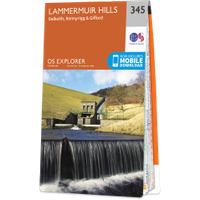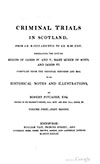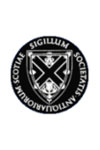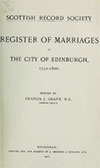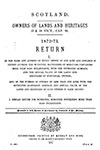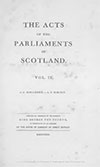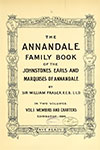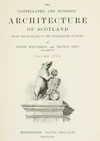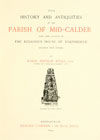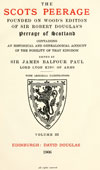

image courtesy of The Edinburgh Star
Polton was a castle owned by the Ramsay family which was later replaced by or incorporated into the 17th and 18th century Polton House. The house was demolished in 1977 and the site is now occupied by an industrial estate.
The lands and mill of Polton originally belonged to the chapel and hospital of St Leonard’s which was situated around 1km downstream from the site of Polton House on the opposite bank of the River North Esk, close to the bridge. The patronage of the chapel and hospital was held by the Ramsays of Dalhousie.
By the 15th century the lands of Polton were the property of the Ramsays of Polton, a cadet branch of Dalhousie, and some time before 1496 Katherine Ramsay, daughter of William Ramsay of Poltoun, married Sir John Sinclair of Driden.
In July 1500 Sir David Ramsay, the chaplain of the hospital and parson of Foulden, with the consent of the hospital’s patron, Sir Alexander Ramsay of Dalhousie, granted the lands and mill of Polton in feu to William for twenty-four merks annually. William witnessed various charters and documents during the early 16th century, including several in favour of the Ramsays of Dalhousie.
It is assumed that William built a castle at Polton, on a spur of land jutting out above the North Esk, however any record of this has been lost. The site offer commanding views over the valley of the North Esk towards Edinburgh and the coast.



William’s son, also William, was involved in the murder of Thomas McCartney in Aberdeen in 1561, and in 1562 the elder William was a surety for his cousin, George Ramsay of Dalhousie, who was on trial for “Abiding from the Raid of Jedburghe”. In 1563 Alexander Ramsay, rector of Foulden, went “to the dwelling-place of Williame Ramsay of Poltoun” because William had failed to pay his annual rent for five years. In 1571 Oliver Ramsay of Poltoune was one of several people on trial for “Abiding from the Raid of Leith”, and the following year saw the trial of the younger William Ramsay and others for the 1561 murder.
By 1577 a Richard Abercromby, a bailie of Edinburgh, was designed of Polton suggesting that he had been granted a feu of the lands of Polton by this time. Whether this was as a result of the Ramsays’ legal woes leading to financial problems is not clear, however the transfer of ownership does not seem to have been an amicable one. In 1577 and 1578 George Ramsay of Dalhousie, along with his son William, and his brothers-in-law William Borthwick of Collilaw and John Gibson, was charged before the Privy Council “with having committed serious outrages on the lands of Richard Abercromby of Polton”. Ramsay’s party “had killed six horses, had deforced the messenger sent to summon them, killed one of the witnesses, and generally behaved most outrageously”.
Richard Abercromby continued to own Polton into the early 17th century but by 1633 Easter and Wester Poltoun were evidently owned by Sir John Nicolson, first baronet, of Lasswade, who had acquired Dryden and Lasswade in the early 1590s. In 1637 Sir John granted the lands of Lasswade, Dryden and Easter and Wester Polton to his son, also Sir John, however the younger Sir John predeceased his father in 1648. The elder Sir John died in 1651 and was succeeded by his grandson, another John.
In 1669 Sir John Nicolson, second baronet, of Lasswade and his wife, Janet Gilmour, second daughter of Sir John Gilmour of Craigmillar, disponed the lands of Poltoun to John Johnston, a merchant in Edinburgh. The Ramsays seem to have retained an interest in Polton until around this time as William Ramsay and his mother, Margaret, sold part of the lands of Polton to Johnston, and in 1671 Sir John Nicolson granted a tack, to Margaret Ramsay, relict of William Ramsay, portioner of Polton, of houses and yards in Lasswade for her lifetime.
It would seem that Johnston was responsible for extending or remodelling the old house, suggested by the existence of a dormer window stone carved with the date 1672. This was later incorporated into a garden feature on the property along with parts of two sundials and other carved architectural fragments, the stones arranged to form a rockery against a garden wall.

Edinburgh, 1890
The following year Johnstone’s daughter and heiress, Magdalene, married James Murray of Outerston, fourth son of Sir William Murray of Newton, first baronet. In 1676 Johnston registered arms with the Court of the Lord Lyon with his crest consisting of a “spur proper, winged silver”.
In the fourth quarter of the 17th century Johnston commissioned two sundials which have been described as of exceptional design. One was decorated with a relief carving of Death holding a scythe and encircling a globe, with a square dial face below the figure. To the left of this in the rockery was a carved figure, and to the right a smaller carved head, both evidently fashioned to support other carved elements. These two stones, along with the carved finial placed on the top of the arrangement, are stylistically similar to others at Newbattle.
The fragments of the other sundial consist of a large cuboid stone carved with hemispherical hollows and surrounding relief details. Sitting on top of this was a second stone, the lower half of which is cuboid in form and the upper half hexagonal with both halves featuring a dial. The cuboid section is also carved with the date 1685 while the polygonal stone is carved with the initials I.I. (Latin forms of J.J.) for John Johnston and A.M., presumably for his wife whose name seems to have been lost.

Edinburgh, 1892
Johnston was nominated as a tutor by the Earl of Dalhousie to the Earl’s children in 1688 but was dead by 1690 and was succeeded by his son-in-law who was then styled as James Murray of Polton. Murray seems to have sold Polton as in 1711 it was bought by William Calderwood who was appointed an Ordinary Lord of Session in that year, taking his seat as Lord Polton.
Around 1725 Sir William had a square-plan summer house built in the grounds of Polton House, featuring fine painted trompe-l’oeil wood panelling.
Sir William Calderwood of Polton died in 1733 and was succeeded by his eldest son, Thomas, who inherited considerable wealth from his father along with Polton itself. Two years later Sir Thomas married Margaret Stewart, daughter of the Solicitor General, Sir James Stewart, first baronet, of Goodtrees and Coltness. Margaret excelled at management and her husband entrusted the running of Polton entirely to her.
Margaret’s brother, also Sir James, had Jacobite sympathies and moved to France in 1745, later relocating to Flanders. Margaret and Sir Thomas decided to join them, partly to give their sons “the benefit of the Continental schools.” In early summer 1756 the family moved to Brussels. Margaret was a prolific letter-writer and kept journals, and these writings were later collected together in the book Letters and Journals of Mrs. Calderwood of Polton, which was illustrated with an etching of Polton House.

Edinburgh, 1884
Upon their return Margaret continued running the estate, and in 1767 sold her husband’s estate of Bonjedward in order to buy the barony of Linhouse for £9600.
Sir Thomas died in 1773, and was succeeded by their eldest son, William. Margaret died 8 months after her husband in 1774. Colonel William Calderwood of Polton and Linhouse died without issue in Lausanne in 1787. Since he had been predeceased by his younger brother, Captain James Calderwood, he was succeeded by their sister, Anne. She had married James Durham of Largo in 1753, and her husband subsequently assumed the name James Calderwood-Durham.
In 1793 Anne conveyed the barony of Linhouse to trustees with an instruction to sell it in order “to pay off certain debts affecting the entailed estate of Polton”, however she died in 1796 before it had sold. It was finally sold to James Home, clerk to the Signet, for £10,920 in 1799.
Her husband died in 1808. Their first son, James, succeeded to Largo. Their second son had died in infancy and so the third son, Thomas, succeeded to Polton. Thomas died in 1815 and was succeeded by his eldest son, James Stuart Durham Calderwood of Polton, however James died in Lausanne in 1818 and was succeeded by his brother, Thomas. Thomas, who also succeeded to Largo in 1840, died at Largo without issue in 1842 and was succeeded by his uncle, Admiral Sir Philip Charles Henderson Calderwood Durham of Fordell, Polton and Largo.
The Admiral died in Naples in 1845 and was succeeded by his niece, the sister of James and Thomas, Lillias Calderwood Durham. She had in 1822 married Robert Dundas of Arniston after dinner at Polton House.
They seem to have resided primarily at Largo and Arniston however after Robert’s death in 1838 she went to live at Polton and had the Largo Pictish stone moved from Largo to Polton where it stood on a plinth in the kitchen garden. It may have been around this time that the parts of the two 17th century sundials were rearranged and built against a garden wall with other architectural fragments.
Lilias died in 1883 and was succeeded by her son, Sir Robert Dundas, first baronet, however he preferred to live at Arniston and Polton was rented out. Tenants included James Balfour, Writer to the Signet, his son, James Heriot Balfour-Melville, also a Writer to the Signet, Gordon Caldwell and Colonel Lewis Anstruther Hope.
Sir Robert died in 1909, his wife having predeceased him, and was succeeded by their son, Sir Robert, second baronet, however he died in 1910. His widow, Lady Evelyn, remained at Arniston and so his brother and heir, Captain Sir Henry Herbert Philip Dundas, third baronet, took up residence at Polton along with his wife, Lady Beatrix, and their children.
In 1930 Sir Henry Dundas died on his way to South Africa, where he had business interests, and was buried at sea. His death seems to have prompted Polton to once again be rented out, as the Misses Miller-Richard were listed as resident the following year. In 1942 Sir Henry’s eldest son, Sir Philip, fourth baronet, made Polton House available for use as a home for around forty European Jewish Kindertransport refugee children aged between 13 and 17.
Following the end of the Second World War Sir Philip sold Polton House in 1946. He gave the sundial stones from Polton to one of his younger brothers, James Durham Dundas, who subsequently set up the stones in the garden of his new house, Birkinshaw, at Traquair in 1957. However by this time the largest cube at the bottom of the architectural fragment garden feature was missing, as was the 1672 dormer stone and the carved finial.
Polton House was demolished in 1977, however prior to demolition various architectural details were salvaged. Fine pine panelling with two secret doors, architraved doors, timber cornicing and Corinthian pilasters were taken from Polton and installed in Queen Mary’s Room at Rossend Castle in Fife. The trompe-l’oeil wood panelling from the summer house was also saved, removed in 1983 by David Drummond, Earl of Perth, and installed in 1989 in a purpose-built octagonal summer house, known as The Folly, at Stobhall in Perthshire.
In 2011, with the sale of Birkinshaw imminent, the heir of James Durham Dundas, Davina Findlay, applied for planning permission to move the sundial stones to her cousin’s property, Arniston House, where they were installed the following year.
The site of Polton House is now occupied by Poltonhall Industrial Estate. The summer house is still standing, now swallowed up by modern housing off Polton Drive.
Alternative names for Polton
Poiltoun; Polting; Polton House; Poltonhall; Poltoun; Poltoune; Poulton; Powtoun



